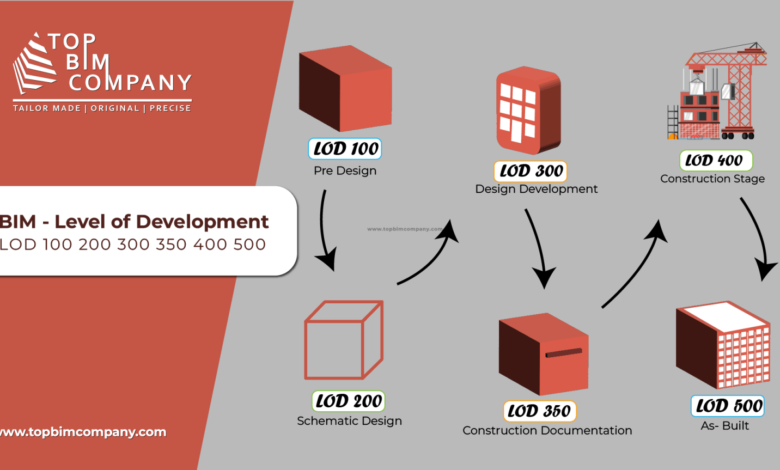Understanding Different Levels of Detail in BIM Models

Introduction
Building Information Modeling (BIM) has revolutionized the architecture, engineering, and construction (AEC) industry by providing a digital representation of the physical and functional characteristics of a building. Central to BIM is the Levels of Development (LOD) concept, which defines the different stages of a BIM model’s detail and accuracy throughout a project’s lifecycle. Understanding these levels is crucial for anyone involved in BIM services, as it ensures that all stakeholders have a clear and consistent understanding of what is being communicated at each project stage.
What Are BIM Levels of Development (LOD)?
Levels of Development (LOD) in BIM refer to the degree of detail included in a model at different phases of a construction project. The American Institute of Architects (AIA) established the LOD framework, which provides a standardized system that defines how much information a BIM model contains at various stages. This ensures that everyone involved in a project—from designers and contractors to owners and facility managers—can rely on the same expectations for the model’s content.
The LOD system typically ranges from LOD 100 to LOD 500, each representing a different level of detail and accuracy. To understand their significance in BIM services, let’s explore these levels in detail.
LOD 100: Conceptual Design
At LOD 100, the BIM model represents the most basic and conceptual information about a project. This level is typically used during the initial planning and schematic design phase. The model may include massing studies, general locations, and approximate shapes but lacks specific details or precise dimensions. It’s mainly used for early-stage feasibility studies and high-level decision-making. For example, a building’s general footprint and height might be represented, but specific details like windows, doors, or materials are not yet included.
LOD 200: Schematic Design
LOD 200 is where the model starts to take shape with more defined components. At this level, the model includes approximate geometry, dimensions, and locations of building elements. However, the details are still generic, and the model might use placeholders for specific components. LOD 200 is often used during the schematic design phase, allowing for more accurate cost estimates and project scheduling while maintaining change flexibility. For instance, structural columns might be represented with approximate sizes and locations, but the exact type of material or connections may not yet be determined.
LOD 300: Design Development
At LOD 300, the BIM model becomes much more detailed and accurate. This level is typically associated with the design development phase, where the model includes precise geometry, dimensions, and locations of all building components. The model at this stage can be used for construction documentation, coordination, and clash detection. For example, HVAC systems, electrical conduits, and plumbing fixtures are accurately modeled and located within the building. LOD 300 models are detailed enough for cost estimation and construction planning, making it a critical stage in BIM services.
LOD 350: Construction Documentation
LOD 350 takes the details further by incorporating information on the assembly of building components. This includes connections between elements, interfaces, and supports. At this level, the model is used for coordination between different trades, ensuring that the design intent is fully understood and that there are no conflicts during construction. For example, structural steel beams in the model would include details on connecting to columns, and mechanical systems would show how they interface with the building’s structure. LOD 350 is often used for detailed coordination and fabrication purposes.
LOD 400: Construction Ready
LOD 400 is where the model becomes “construction-ready.” At this level, the model includes all the information needed for fabrication and installation. Every component is modeled with precise geometry, dimensions, and specifications. LOD 400 models are used for off-site fabrication, on-site assembly, and installation. For instance, a steel beam in a LOD 400 model would include exact dimensions, fabrication details, material specifications, and connection methods. This level of detail is essential for contractors and fabricators to accurately produce and install components without further interpretation or adjustments.
LOD 500: As-Built
LOD 500 represents the final stage of a BIM model, often referred to as the “as-built” model. At this level, the model reflects the actual conditions of the completed building, including all changes made during construction. The LOD 500 model is typically used for facilities management, maintenance, and operations. It provides a precise digital representation of the building that can be used for long-term management and future renovations. For example, the model will show all building systems’ exact locations and specifications, down to the smallest detail, such as pipe fittings or electrical outlets.
The Importance of LOD in BIM Services
Understanding and implementing the appropriate LOD at each project stage is critical for the success of BIM services. It ensures that all project stakeholders—architects, engineers, contractors, and owners—understand what the BIM model represents at any given time. This clarity helps prevent misunderstandings, reduces the risk of errors, and ensures that the project progresses smoothly from design to construction and beyond.
Moreover, the LOD framework enables better communication and collaboration across the project team. Defining the level of detail and information required at each stage makes it easier to coordinate efforts, manage expectations, and deliver a project that meets the client’s needs. Additionally, using LOD in BIM services enhances the accuracy of cost estimates, scheduling, and resource allocation, leading to more efficient project delivery.
Conclusion
BIM Levels of Development (LOD) are crucial in defining the detail and accuracy of BIM models throughout a construction project. Each level serves a specific purpose in the project’s lifecycle from the conceptual design stage (LOD 100) to the as-built model (LOD 500). For those providing or utilizing BIM services, a deep understanding of LOD is essential for ensuring that the project’s goals are met precisely and clearly. By implementing the appropriate LOD at each stage, you can optimize collaboration, reduce errors, and deliver a successful project that meets the highest quality and performance standards.



